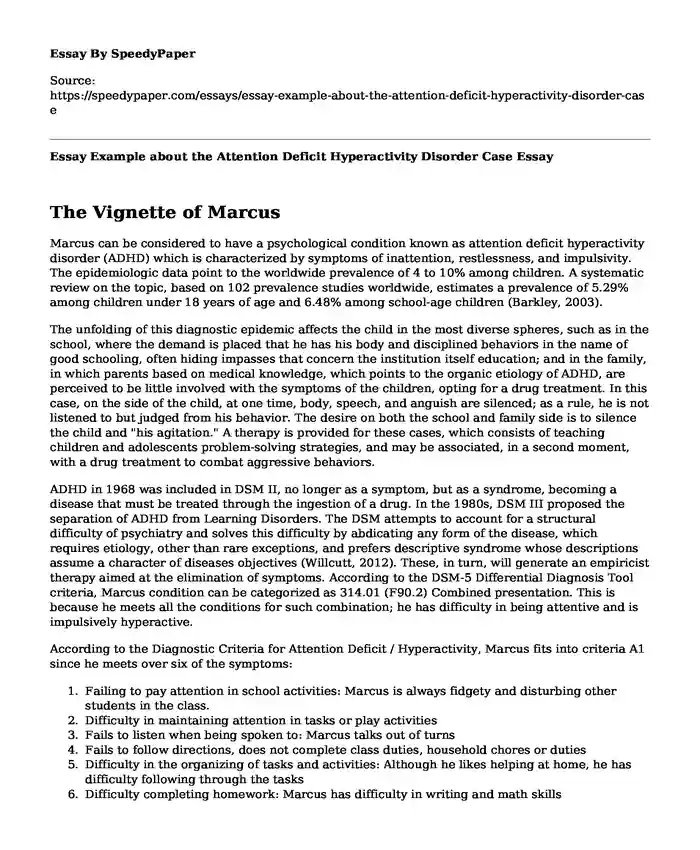
| Type of paper: | Essay |
| Categories: | Mental disorder |
| Pages: | 3 |
| Wordcount: | 590 words |
The Vignette of Marcus
Marcus can be considered to have a psychological condition known as attention deficit hyperactivity disorder (ADHD) which is characterized by symptoms of inattention, restlessness, and impulsivity. The epidemiologic data point to the worldwide prevalence of 4 to 10% among children. A systematic review on the topic, based on 102 prevalence studies worldwide, estimates a prevalence of 5.29% among children under 18 years of age and 6.48% among school-age children (Barkley, 2003).
The unfolding of this diagnostic epidemic affects the child in the most diverse spheres, such as in the school, where the demand is placed that he has his body and disciplined behaviors in the name of good schooling, often hiding impasses that concern the institution itself education; and in the family, in which parents based on medical knowledge, which points to the organic etiology of ADHD, are perceived to be little involved with the symptoms of the children, opting for a drug treatment. In this case, on the side of the child, at one time, body, speech, and anguish are silenced; as a rule, he is not listened to but judged from his behavior. The desire on both the school and family side is to silence the child and "his agitation." A therapy is provided for these cases, which consists of teaching children and adolescents problem-solving strategies, and may be associated, in a second moment, with a drug treatment to combat aggressive behaviors.
ADHD in 1968 was included in DSM II, no longer as a symptom, but as a syndrome, becoming a disease that must be treated through the ingestion of a drug. In the 1980s, DSM III proposed the separation of ADHD from Learning Disorders. The DSM attempts to account for a structural difficulty of psychiatry and solves this difficulty by abdicating any form of the disease, which requires etiology, other than rare exceptions, and prefers descriptive syndrome whose descriptions assume a character of diseases objectives (Willcutt, 2012). These, in turn, will generate an empiricist therapy aimed at the elimination of symptoms. According to the DSM-5 Differential Diagnosis Tool criteria, Marcus condition can be categorized as 314.01 (F90.2) Combined presentation. This is because he meets all the conditions for such combination; he has difficulty in being attentive and is impulsively hyperactive.
According to the Diagnostic Criteria for Attention Deficit / Hyperactivity, Marcus fits into criteria A1 since he meets over six of the symptoms:
- Failing to pay attention in school activities: Marcus is always fidgety and disturbing other students in the class.
- Difficulty in maintaining attention in tasks or play activities
- Fails to listen when being spoken to: Marcus talks out of turns
- Fails to follow directions, does not complete class duties, household chores or duties
- Difficulty in the organizing of tasks and activities: Although he likes helping at home, he has difficulty following through the tasks
- Difficulty completing homework: Marcus has difficulty in writing and math skills
- The patient is distracted easily: Marcus is often fidgety and leaves his seat to disturb others.
- Frequently shows forgetfulness: The child always gets in trouble for forgetting to follow instructions.
Except for therapy, the following medications can be used in ADHD treatment
- Methylphenidate: Ritalin 5 to 20 mg to 3 times a day, from 4: 4h.
- Concerta
- Ritalin LA
- Imipramine, Atomoxetine, or Clonidine.
References
ATTENTION-DEFICIT, S. O. (2011). ADHD: clinical practice guideline for the diagnosis, evaluation, and treatment of attention-deficit/hyperactivity disorder in children and adolescents. Pediatrics, peds-2011.
Barkley, R. A. (2003). Issues in the diagnosis of attention-deficit/hyperactivity disorder in children. Brain and development, 25(2), 77-83.
Willcutt, E. G. (2012). The prevalence of DSM-IV attention-deficit/hyperactivity disorder: a meta-analytic review. Neurotherapeutics, 9(3), 490-499.
Cite this page
Essay Example about the Attention Deficit Hyperactivity Disorder Case. (2022, Oct 24). Retrieved from https://speedypaper.net/essays/essay-example-about-the-attention-deficit-hyperactivity-disorder-case
Request Removal
If you are the original author of this essay and no longer wish to have it published on the SpeedyPaper website, please click below to request its removal:
- Essay Example on Cost Overruns
- Dissertation Example on Dabbawala
- Essay Sample on How Is Petroleum Formed
- Essay Sample in US History: Most Important Changes in the US in 1877-1945
- Virtue Ethics, Free Essay in Philosophy
- Is Technology Current Event 2? Essay Sample
- Paper Sample. Advantages of Using Comparative Statements for Financial Analysis
Popular categories




